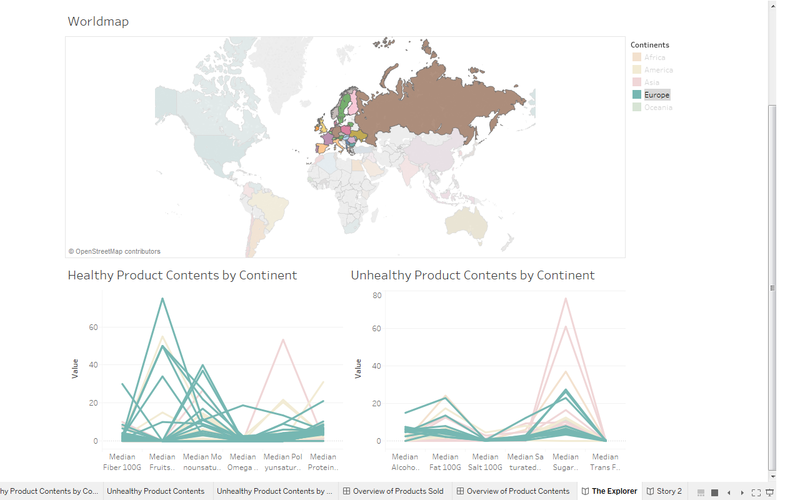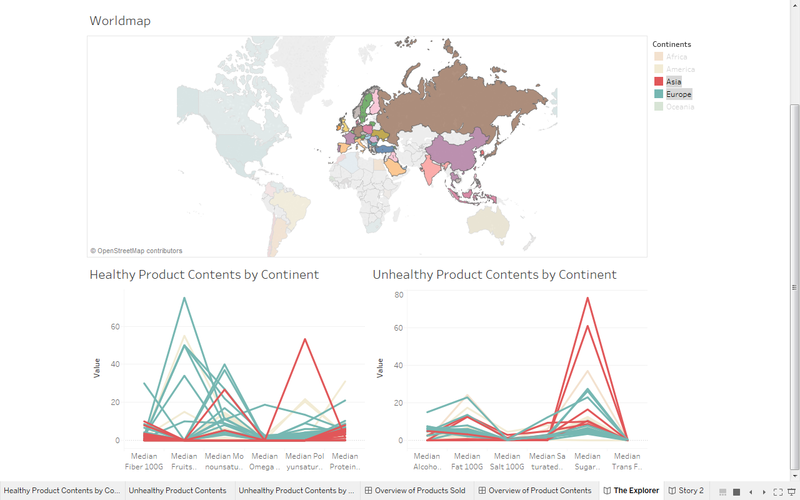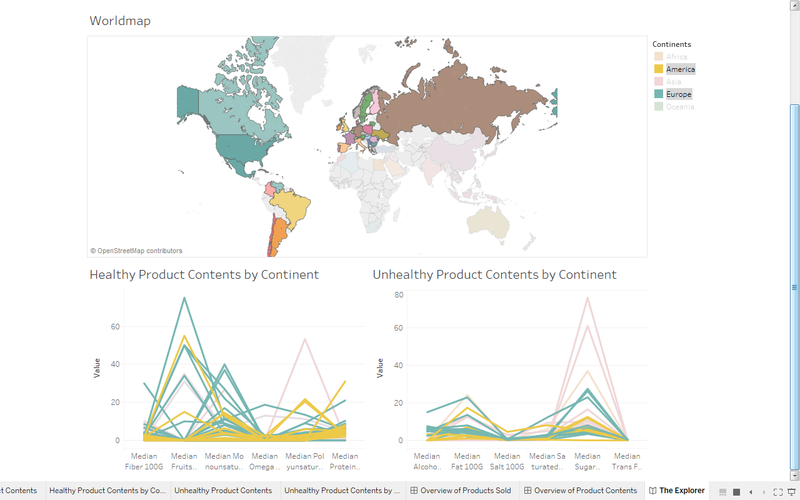IS428 2016-17 Term1 Assign2 Timothy Tan Swee Guang
Perception and Data: How the media influences perceptions of consumption patterns around the world
Contents
Abstract
Problem and Motivation
With the ubiquitous presence of the media in everyday life, it is easy for us to form conscious or unconscious perceptions of different societies based on what the media portrays it to be. For example, the media always depict European meals as fresh and healthy (I.e. Italian Pastas, Paella from Spain, Greek Salads or fresh fish from the Netherlands) whilst associating fast-food or unhealthy foods to countries like the US or Canada. But is this really true? Or is the media truly biasing our perceptions?
This study aims to explore how media can influence our perceptions on how we perceive differing countries consumption patterns. Through the use of food facts, the study attempts to proxy how media bias our views on how healthy or unhealthy a country truly is through its advertisements on what they eat.This study will proxy products availability in a country as an indicator of what people eat in that country.
Health Indicators
Healthy Measures (per 100g)
- Fiber
- Fruits, Vegetables and Nuts
- Monounsaturated Fat
- Omega 3 Fat
- Polyunsaturated Fat
- Proteins
Unhealthy Measures (per 100g)
- Alcohol
- Fat
- Salt
- Saturated Fat
- Sugars
- Trans Fat
Approaches
Data Preprocessing
1. Removed "Null" Product Names
2. Treated "Countries_en" column
- Delimited multivalued cells
- Stacked Columns
3. Treated "main_category_en" column
- Removed names with ":" by formula
4. Standardized "Product_Category_D1" to start with lowercase to resolve double-counting issues
5. For the measures, only attributes that seem to be good predictors of health were kept.
- Data points without any measures were excluded (22,026 rows were filtered out due to all 26 measurements missing [this 26 includes the measures of interest]. Leaving 39,996 rows left for analysis)
6. Organized Groupings
- Grouped Countries by Continents
- Grouped Measures by Folders
Research Questions
- What products are the different countries consuming?
- What product contents are the different countries consuming?
- What are some of the patterns of products available in each country?
- How healthy or unhealthy are these products?
- Which continent eats the healthiest?
- Are there different patterns of consumption between Europe and America as showcased on television?
- Are these patterns align to what media portrays them to be?
- If Europe and America's consumption patterns differ, what are they consuming differently? What are the reasons for these differences?
Link to Interactive Dashboard
https://public.tableau.com/profile/timothy.tan5930#!/vizhome/TableauA2/TheExplorer
Analysis
Healthiest Continent
In terms of healthy measures (Figure 1a), Europe seems to be consuming greater amounts of healthy products than any other continents. Europeans seem to eat fruits, vegetables and nuts more than most countries and also take more monounsaturated fat more. This higher intake of monounsaturated fat comes to no surprise as Europeans do appear to have their meals with olive oil and cook with it more often than other countries.
What is interesting is that, we can see the exact same type of pattern when it comes to the intake of polyunsaturated fat in Asia, specifically, Hong Kong (Figure 1b). The intake of this particular type of fat is due to the oils (I.e. Sesame oil, Sunflower Oil, Canola Oil etc.) Asians tend to use to cook with. A stark difference in types of oil usage for cooking can clearly be seen here between the Europeans and Asians.
Consumption Differences: Europe vs America
Comparing the consumption patterns of Europeans and Americans (Figure 2a), it does seem like Europeans consume healthier products than Americans. Having said that, Europeans and Americans do not seem to differ much in terms of their unhealthy products consumption. This pattern seem to show support to what media portrays on television that Europeans do eat healthy. However, it is noteworthy to point out that the media might be choosing to portray European cuisine as being healthy and giving a twisted perception of American cuisine as being unhealthy. This can be inferred as there are no clear difference between the continents in terms of unhealthy product consumption.
Consumption Differences: A Deeper Look
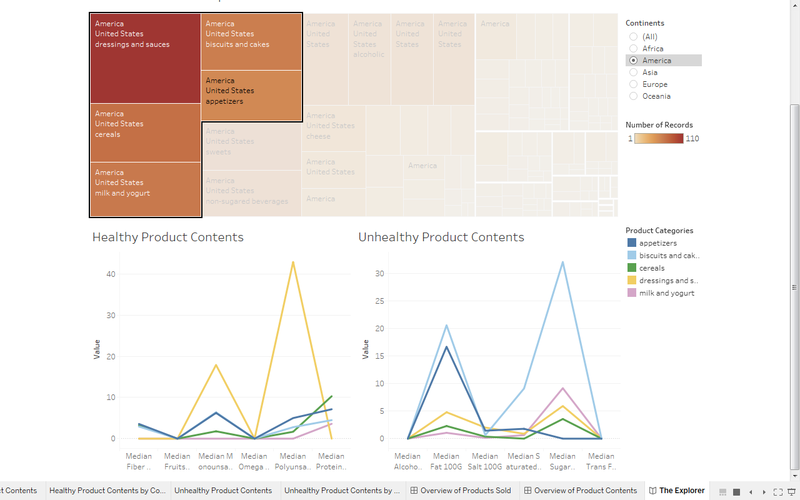
Figure 2b - America
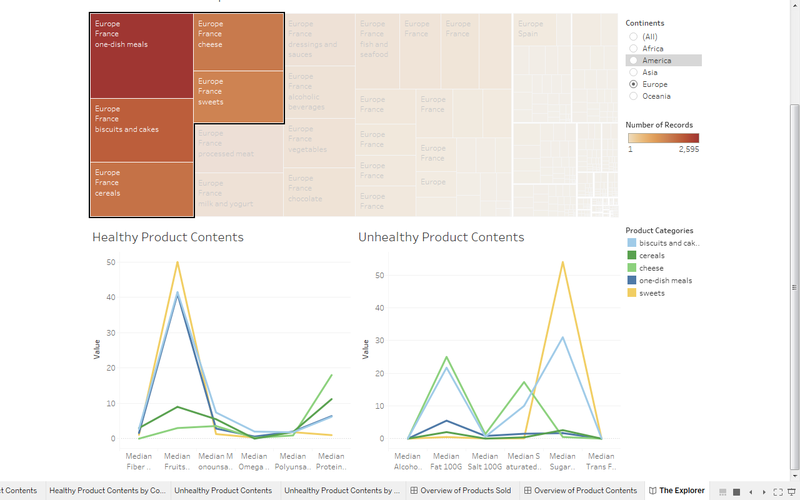
Figure 2c - Europe
Take a look at the side by side comparison of the top 5 products consumed in each continent. A few key patterns can be seen here (Figure 2b & 2c).
Firstly, the consumption patterns in Europe mostly came from France while in America, came from the United States (US).
Secondly, a few consumption differences have been brought to light. In France, One-dish meals, Cheese and Sweets are the top 5 products consumed while in the US, dressing and sauces, milk and yogurt and appetizers are in the top 5. Biscuits & Cakes and Cereal seem to be the common products in both countries. From here, it becomes evident why the initial findings suggested that Europeans (or much rather, France), eat healthier than Americans. All of the top 5 products the French consume contain high levels of fruit, vegetables and nuts. Juxtaposed to the US, who has only it's dressings and sauces that gives its health benefits via healthy oils. Again, in terms of healthy consumption patterns, it looks like the data confirms what the media has been portraying on television. The French from Europe do eat healthier than Americans in the US.
Comparing Unhealthy Consumption Patterns: France vs USA
Comparing across the top 5 products between the two countries (Figure 2b & 2c), we can see that in actuality, French products contain more unhealthy contents than the US in terms of total grams of fat, sugar, salt etc. (France vs US: 175.96g vs 113.5g unhealthy contents). This is a significant finding as it supports the initial hypothesis on how media can bias our perceptions on viewing a country as being unhealthy or healthy. It looks like the US is not as unhealthy as it is made out to be. Although the media could potentially be on to some truth by portraying the US as being more unhealthy (i.e. basing their content on the US growing obesity rates), they might be placing more weight on this perception than they ought to be without realizing it's widespread impact.
Tools Utilized
- Excel 2013 for data preparation
- SAS Enterprise Guide for data preparation
- JMP-PRO for data preparation
- Tableau for visualization
References
http://www.webmd.com/diet/obesity/features/skinny-fat-good-fats-bad-fats#1
http://statisticstimes.com/geography/countries-by-continents.php
